1 In which situation is a hypothesis test most likely to end
1.
In which situation is a hypothesis test most likely to end with a significant result?
A) 20 subjects in each comparison group and a very effective treatment.
B) 100 subjects in each comparison group and a very effective treatment.
C) 20 subjects in each group and a barely effective treatment.
D) 100 subjects in each group and a barely effective treatment.
2.
In which situation is a hypothesis test most likely to end without a significant result?
A) 20 subjects in each comparison group and a very effective treatment.
B) 100 subjects in each comparison group and a very effective treatment.
C) 20 subjects in each group and a barely effective treatment.
D) 100 subjects in each group and a barely effective treatment.
3.
A restaurant chain wishes to investigate whether changing the color of the shirts worn by their waiters, from the
current beige, has
an effect on the amount of money their customers spend. They decide to do an experiment at each of 20 of their
restaurants
(testing a different color at each place by alternating what color the staff wears each day for two weeks and then comparing
the average bills under each color condition). In one restaurant they test whether wearing blue shirts will affect the amount spent;
in a second restaurant they test whether wearing green shirts will affect the amount spent; etc… When they analyze
their data, they
find that the waiters wearing purple shirts had a significant association with a difference in the amount spent. The
most likely
reason for this is that:
A) purple is a pleasing color to many customers.
B) statistical significance does not imply practical significance.
C) you would expect to see one significant result when you carry out 20 significance tests.
D) a third confounding variable is driving both the color worn and the amount spent.
4.
The Gallup Poll takes a sample of 500 adult Americans every day and asks them a series of questions about their
political beliefs;
their employment and consumer habits, and their well being and happiness. Over a period of one month they would
then have the
results from about 15,000 respondents. To make a judgment about whether how much two of these variables are
related to each
other you would want to know:
A) if they are significantly associated because it is most import to rule out random chance.
B) a confidence interval for the degree of association so you can see how close they are aligned.
C) if a confidence interval contains the value corresponding to no association.
5.
True or False: Informed consent is not necessary if the research clearly benefits the subject.
A) True
B) False
6.
If there is a lot of variability from subject-to-subject then:
A) it will be easy to reject the null hypothesis with a small sample
B) it will be likely we don’t reject the null hypothesis with a small sample
C) it will be easy to prove the alternative with a small sample
7.
True or False: If the p-value is small enough then the evidence indicates a big effect.
A) True
B) False
8.
True or False: If the p-value is large enough then the evidence indicates there’s no effect.
A) True
B) False
9.
A new treatment for brain tumors involves placing biodegradable time-releasing pouches of a new drug into the cavity
created during
surgery to remove the tumor. This type of treatment is expected to work better than taking the drug orally, since it will
deliver the
drug straight to the site of the cancer rather than through the blood system where it might harm healthy parts of the
body. To make
the best statistical comparison a study is planned that will use the new procedure on a randomly selected group of
patients and
place similar pouches without the new drug in a control group of patients (with the surgeon unaware of whether the
pouches contain
the new drug or not). All of the subjects taking part would give their informed consent. This would be:
the best scientific study since the surgeon would be blinded to the treatment and the patients would all be treated the
same
except for the presence of the drug.
B) of questionable ethics since the sham treatment (the pouches without drug) may do harm to the patients.
C) of questionable ethics because the patient needs to know how they are being treated.
10.
The language in an informed consent document should
A) be in detailed scientific language so the information is precise
B) be in common language that potential subjects can easily understand
C) avoid giving away what the experiment is about.
| 1. In which situation is a hypothesis test most likely to end with a significant result? A) 20 subjects in each comparison group and a very effective treatment. 2. In which situation is a hypothesis test most likely to end without a significant result? A) 20 subjects in each comparison group and a very effective treatment. 3. A restaurant chain wishes to investigate whether changing the color of the shirts worn by their waiters, from the current beige, has an effect on the amount of money their customers spend. They decide to do an experiment at each of 20 of their restaurants (testing a different color at each place by alternating what color the staff wears each day for two weeks and then comparing the average bills under each color condition). In one restaurant they test whether wearing blue shirts will affect the amount spent; in a second restaurant they test whether wearing green shirts will affect the amount spent; etc… When they analyze their data, they find that the waiters wearing purple shirts had a significant association with a difference in the amount spent. The most likely reason for this is that: A) purple is a pleasing color to many customers. 4. The Gallup Poll takes a sample of 500 adult Americans every day and asks them a series of questions about their political beliefs; their employment and consumer habits, and their well being and happiness. Over a period of one month they would then have the results from about 15,000 respondents. To make a judgment about whether how much two of these variables are related to each other you would want to know: A) if they are significantly associated because it is most import to rule out random chance. 5. True or False: Informed consent is not necessary if the research clearly benefits the subject. A) True 6. If there is a lot of variability from subject-to-subject then: A) it will be easy to reject the null hypothesis with a small sample 7. True or False: If the p-value is small enough then the evidence indicates a big effect. A) True 8. True or False: If the p-value is large enough then the evidence indicates there’s no effect. A) True 9. A new treatment for brain tumors involves placing biodegradable time-releasing pouches of a new drug into the cavity created during surgery to remove the tumor. This type of treatment is expected to work better than taking the drug orally, since it will deliver the drug straight to the site of the cancer rather than through the blood system where it might harm healthy parts of the body. To make the best statistical comparison a study is planned that will use the new procedure on a randomly selected group of patients and place similar pouches without the new drug in a control group of patients (with the surgeon unaware of whether the pouches contain the new drug or not). All of the subjects taking part would give their informed consent. This would be: the best scientific study since the surgeon would be blinded to the treatment and the patients would all be treated the same except for the presence of the drug. 10. The language in an informed consent document should A) be in detailed scientific language so the information is precise |
Solution
1) a) 20 subjects in each comparison group and a very effective treatment [ smaller samples cause a significant p-value and effective would cause difference in values ]
2) D) 100 subjects in each group and a barely effective treatment.
3) C) you would expect to see one significant result when you carry out 20 significance tests [ 20 * ( 0.05) =1 ]
4) A) if they are significantly associated because it is most import to rule out random chance
5) B) False
6) B) it will be likely we don’t reject the null hypothesis with a small sample
7) A) True
8) A) True
9) a)
the best scientific study since the surgeon would be blinded to the treatment and the patients would all be treated the
same
except for the presence of the drug.
10) B) be in common language that potential subjects can easily understand
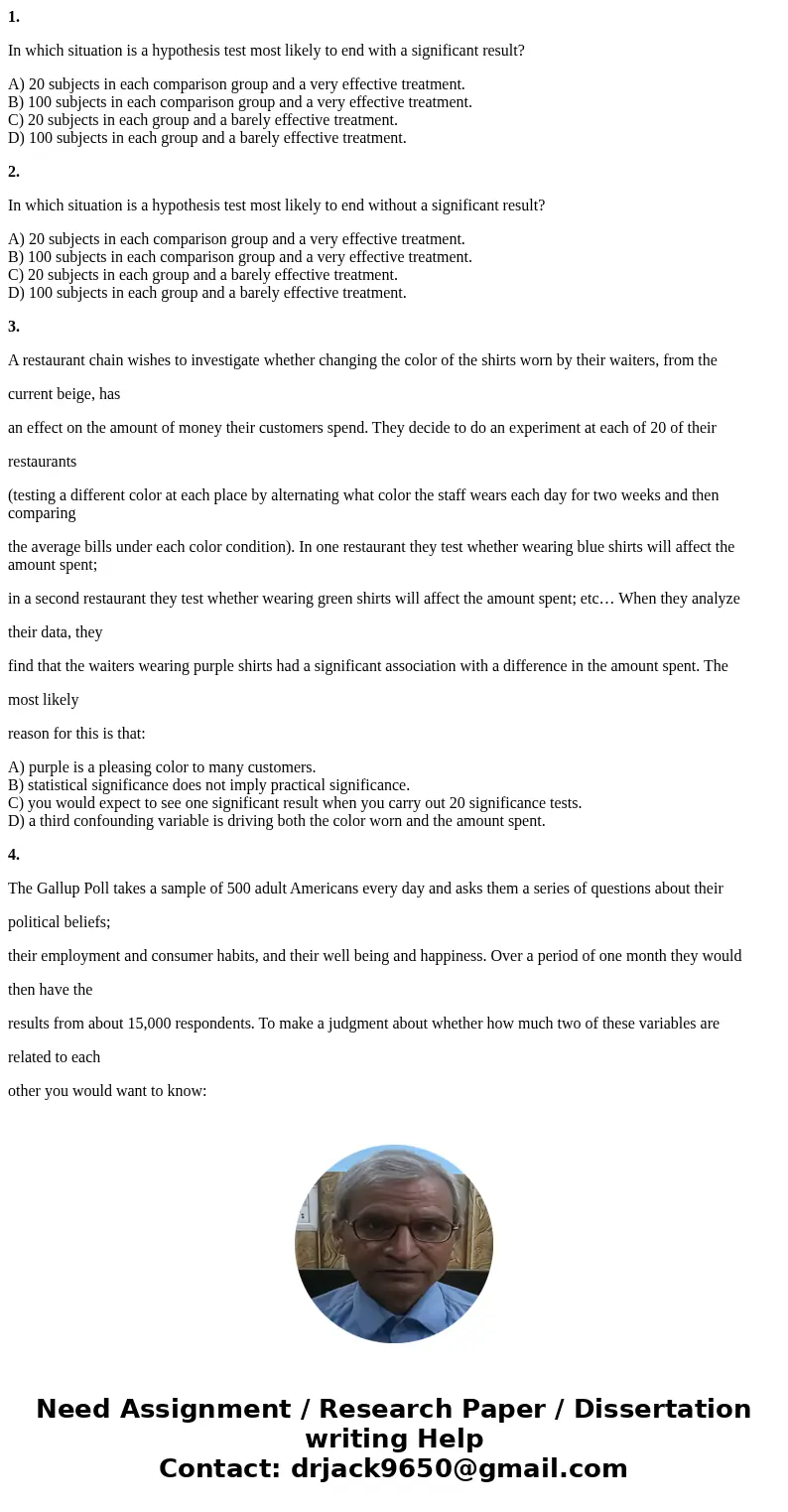
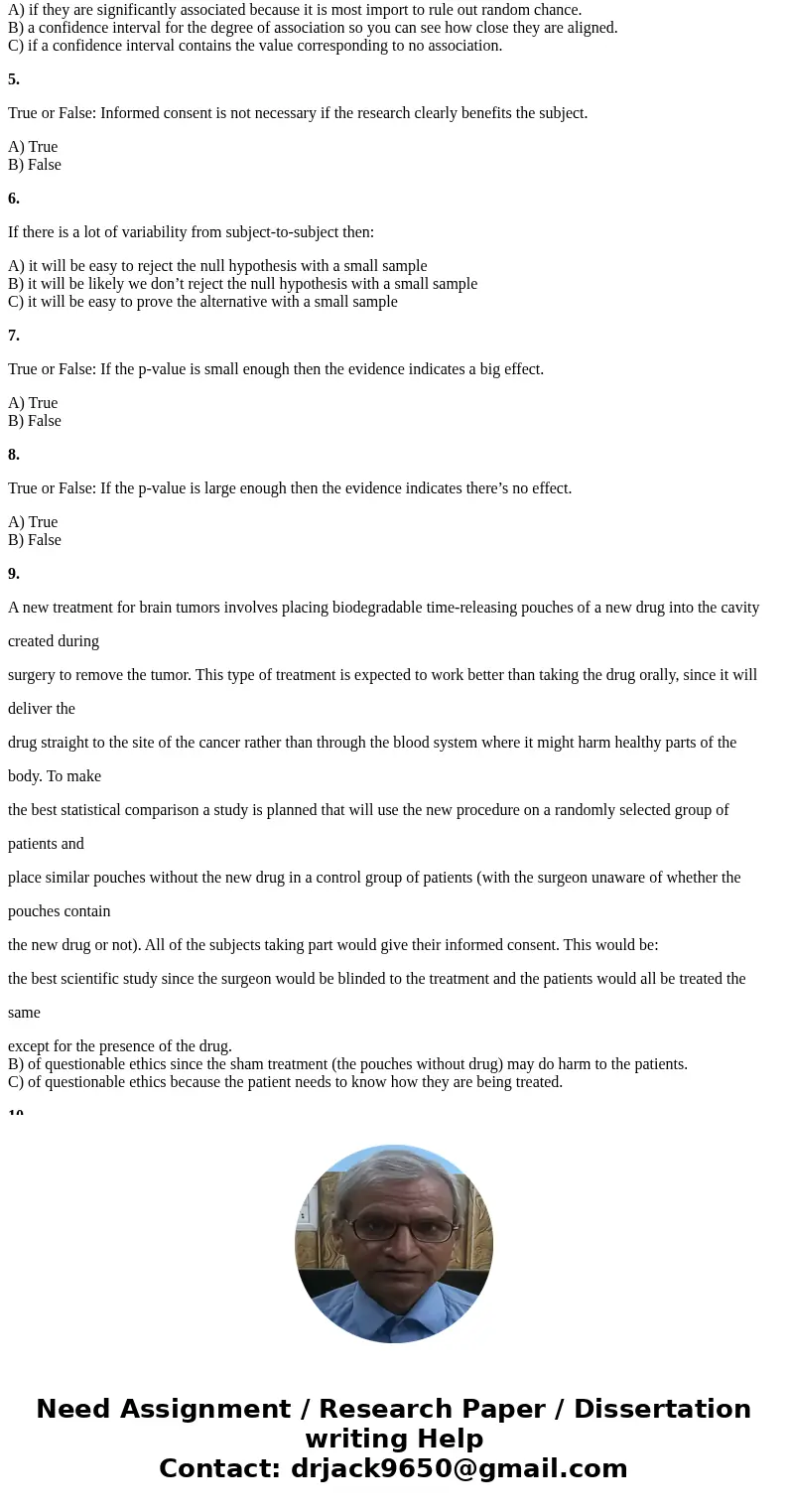
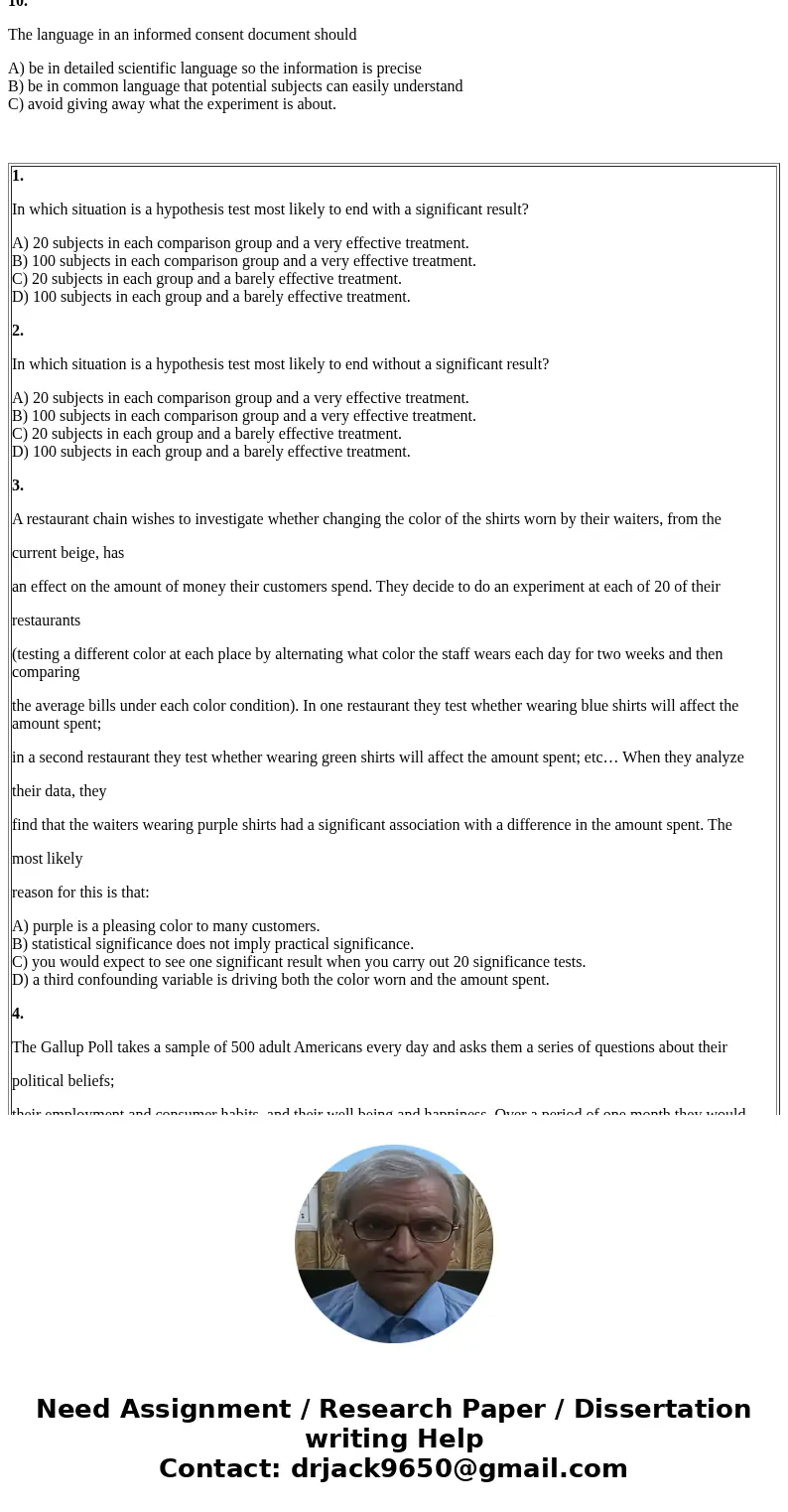
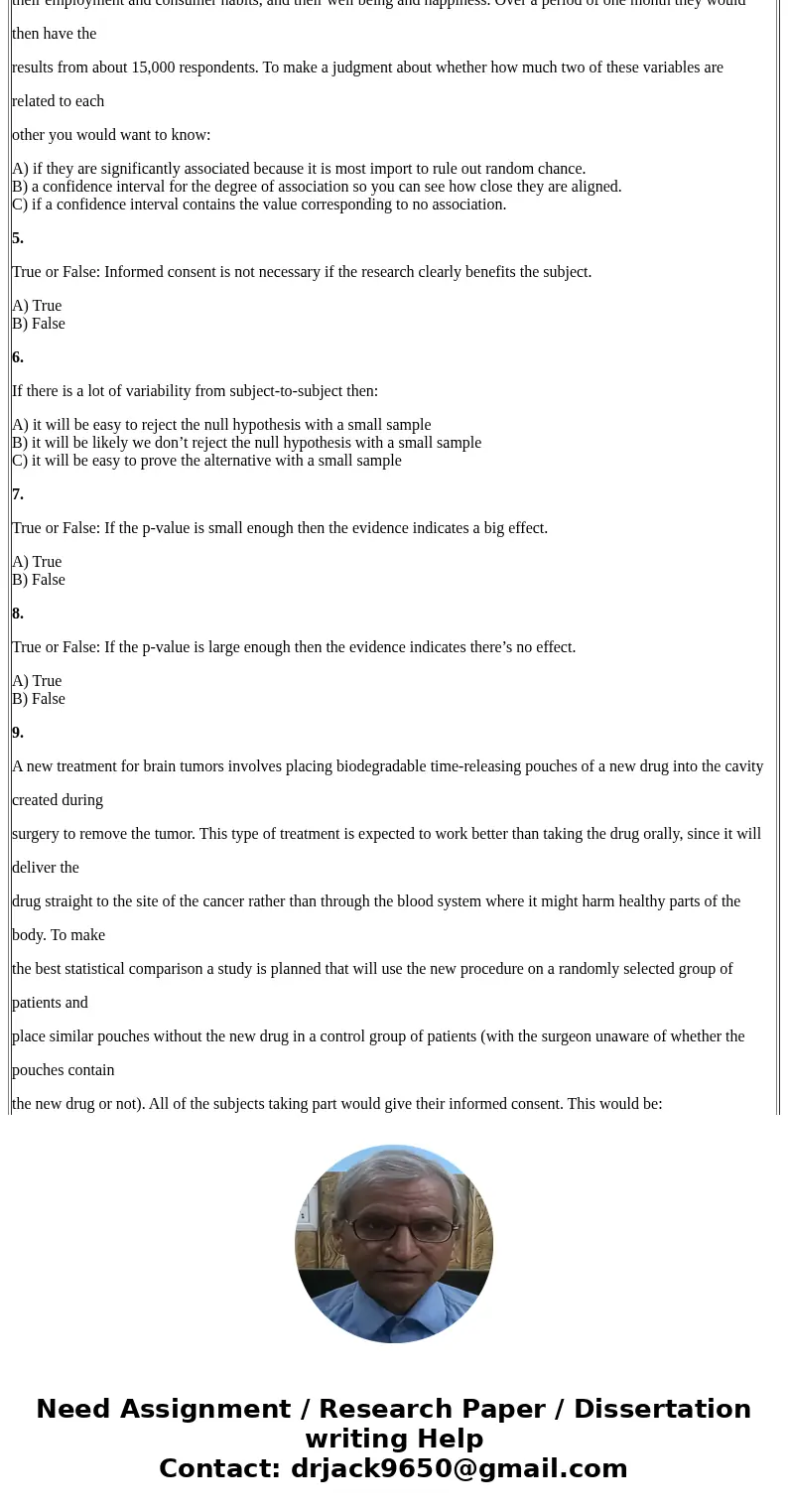
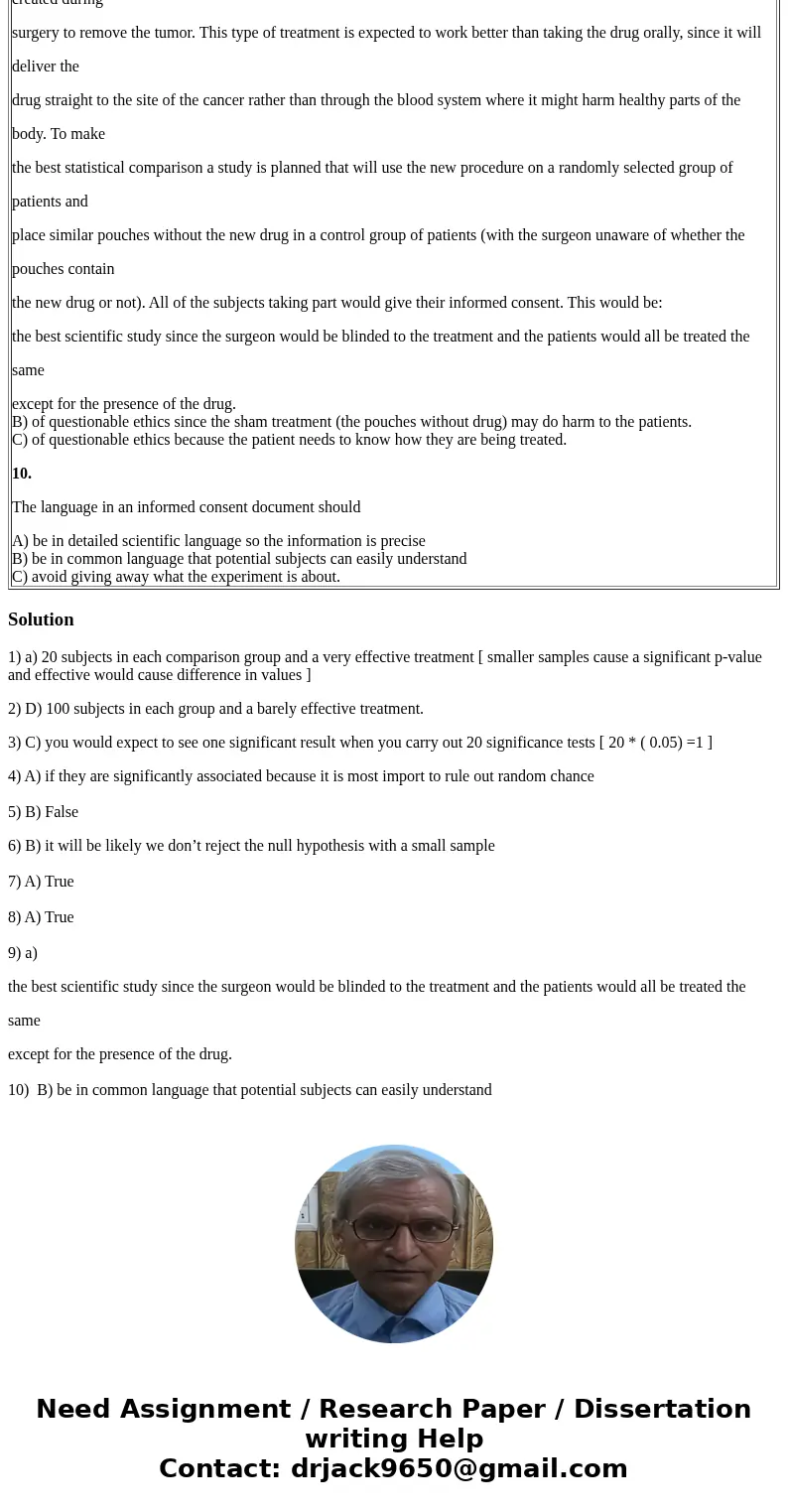
 Homework Sourse
Homework Sourse